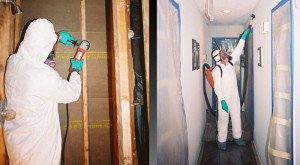 The key to preventing mold growth is controlling moisture, and the best way to do this is to fix water problems and dry water damaged areas thoroughly. Mold is a useful part of the environment… outdoors where it works to break down dead organic matter like leaves. Indoors, however, it can cause damage and health problems if the spores land on a damp surface and begin to grow.
The key to preventing mold growth is controlling moisture, and the best way to do this is to fix water problems and dry water damaged areas thoroughly. Mold is a useful part of the environment… outdoors where it works to break down dead organic matter like leaves. Indoors, however, it can cause damage and health problems if the spores land on a damp surface and begin to grow.
All molds can produce allergic reactions, while some varieties, known as toxic mold, can produce mycotoxins, which can cause respiratory symptoms, skin irritation, and headaches. Mold can also be destructive to the surfaces it grows on.
The best way to manage mold is to prevent the damp conditions that facilitate its growth. That can be easier said than done, however, if you have a hidden moisture problem, such as a plumbing issues or leaks within the walls.
If you find that you have mold growing in your home, it is vital that you identify and remediate the moisture problem along with cleaning up the mold. Cleaning up mold without fixing the moisture problem will only allow mold to regrow.
If the mold covers a large area, more than about 10 square feet, or if the mold is the result of extensive water damage or damage by sewage or contaminated water, you may need to consult with a professional contractor. Consult the EPA’s Mold Remediation in Schools and Commercial Buildings and make sure the guidelines are followed, whether you are doing the work yourself or you hire someone.
If you decide to clean up the mold yourself, keep the following in mind:
- Use protective gear including respirator, gloves, and goggles to avoid exposing yourself to mold and toxins.
- Mold doesn’t grow without moisture, so if you have mold, you have moisture. Be sure to identify and fix the moisture problem, or all other efforts will be wasted, as mold will regrow. If the mold is in the bathroom or other damp area and regrows after being cleaned up, you may need to improve your ventilation.
- Scrub mold from hard surfaces with bleach (if it will not damage the surface) or detergent and water and allow to dry thoroughly.
- Absorbent materials may need to be discarded as it can be difficult, and in some cases impossible, to remove.
- If mold has stained an item that is valuable or sentimental, it may be wise to consult a specialist to find out how best to clean it so you don’t do further damage.
Preventing mold from starting to grow is much easier than trying to kill it and get rid of it after it takes over. Keep indoor humidity low and prevent moisture from accumulating. Take care of leaks, spills, or condensation quickly.
Read on at http://orange-restoration.com/services/san-diego-mold-removal/
No comments